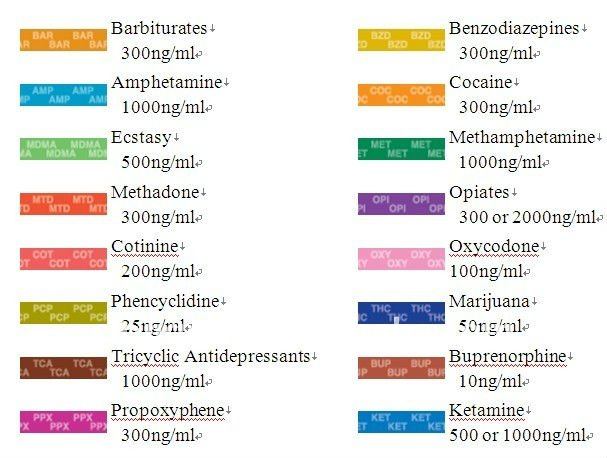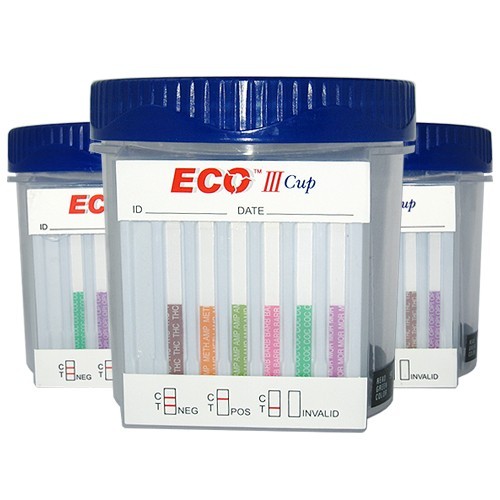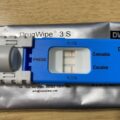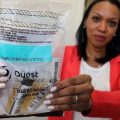The purpose of urine drug testing is to monitor compliance with prescribed therapy and detect the use of non-prescribed and illicit substances. Drug test cups are used to test urine samples for many different drugs that are commonly abused. Drug test cups are often preferred because they are inexpensive, easy to use, and provide test results within a short amount of time.
Test strips or test cards come with these cups and are dipped over the sample for the reading of results. There are different choices when it comes to drug test cups. Among them are those that come from different brands like:
DrugCheck NxStep: This brand launched its very own Onsite Urinalysis Test Cup that can be used easily in the detection of onsite drugs. It makes use of a testing device with its collection cup to detect the presence of various drug metabolites in a matter of minutes. It can test up to 15 drugs and adulterants such as amphetamine (AMP), buprenorphine, cocaine (COC), meth, opiates, phencyclidine and TCA to barbiturate, benzodiazepine (BZO), MDMA/Ecstasy, methadone, oxycodone, propoxyphene and marijuana/cannabis.
T-Cup: This is a convenient, one-step drug test cup. It specifically helps in detecting elevated levels of certain types of drugs and their presence in urine. It is FDA-approved and comes with a security strip that guards against possibilities of specimen adulteration. It comes with a wide-mouth cup opening that makes specimen collection easier and less messy.
E-Z Split Key Cup: This brand offers an integrated urine drug test kit that can be used either by employers, pain centers, clinics and other health centers. This FDA cleared drug test cup is ideal for the needs of many professional organizations and can be used for testing drugs of abuse like antidepressants, benzodiazepines, methadone, oxycodone and propoxyphene.
DrugConfirm Advanced Drug Test Cup: This is the brand that is best suited for home drug test. DrugConfirm is a proven drug abuse prevention tool that is both convenient and confidential for the end user. This is CLIA Waived and FDA Approved. Providing results in minutes, the kit comes with a specimen transport box and a specimen ID card. It can be used to test drugs like cocaine, marijuana, amphetamines, methamphetamines, opiates and phencyclidine. SEE: Can GHB Be Detected In A Drug Test?
iCup Drug Test: This FDA cleared drug test cup is manufactured by Alere Toxicology and offers a wide range of integrated test cups for multi-drug screening. The iCup urine test come in a variety of configurations and offer the ability to detect anywhere from 3 to 13 drugs of abuse in one test. These test cups also come with the option of detecting up to 6 adulterants in one test, helping to all but eliminate urine specimen tampering.
Instant results populate in under 5 minutes and provide up to 99% accuracy while the flat sided results panel makes for ease of photocopying drug test results.
Advantages of Using Urine Cups
Urine drug tests are convenient and affordable. Key features include:
- Various sizes, with graduations in ounces (oz) and milliliter (mL)
- Wide clean-catch brim with screw-on cap
- Rapid results
- Temperature strips
Drug test cups can be used in many different settings. Some examples include:
- Criminal Justice
- Home Drug Testing
- Law Enforcement
- Rehabilitation Centers
- Workplace, Staffing, and Recruiting
- School Protection
Choosing a Urine Test Cup
Urine drug tests can detect many illicit substances, including but not limited to:
- Prescription opiates
- Marijuana (THC)
- Cocaine (COC)
- Amphetamines (AMP)
- Ecstasy (MDMA)
- Synthetic drugs
- Etc.
Some urine test cups are able to detect multiple substances at once, while some are specific for certain drugs. Choosing the right urine test cup for your purposes depends on why you are drug testing and what you are testing for.
There are two basic types of urine drug testing:
Urine Screening Test: This type of test uses immunoassay to find the parent drug and/or metabolite. Immunoassay means the test looks for certain substances and molecules to provide a positive or negative result. Most common drugs screened include cocaine, amphetamines, opiates, marijuana, PCP, methadone, and benzodiazepines (BZO). A urine screening test is fast, but may not be the most reliable result. If a urine screening test is positive, it should always be confirmed using a more specific urine confirmatory test.
Urine Confirmatory Test: This type of urine drug test undergoes gas chromatography/mass spectrometry (GC/MS) or high-performance liquid chromatography (HPLC) testing in a laboratory setting. This test is much more specific than a urine screening test and results are very accurate. This type of urine screening is used in testing for the presence of a specific drug, especially when the initial screening test produces a positive result.
Urine Collection Cup Features
An ideal urine collection cup should have the following specifications:
- It should be sterilized. Bacteria can affect the results of a urine test or render the result invalid. Sterilization also prevents other types of contamination and provides the most accurate results.
- It should hold at least 90 mL of urine. While tests often only need about 30 mL for an accurate read, a large receptacle is necessary for the donor’s ease of use and in case multiple tests are being done.
- There should be a tamper tab to determine if the sample has been contaminated or adulterated. Tamper-evident tabs help indicate if a sample has been adulterated. If the tamper-evident tabs are positive, the sample is invalid and should be repeated.
- The container should be ideal for harsh transport conditions (i.e. does not easily break). This ensures the integrity of the sample during transport to the lab.
- The container must be made of a clear, high-quality polypropylene plastic to keep the sample in great condition even under pressure. It is important to keep the sample in optimal condition to yield an accurate result.
- The cap of the urine collection cup should prevent threading and leaking.
- Containers should be graduated from the inside. This should be in both ounces and milliliters. This helps guarantee that the volume of the sample collected is enough to read a result.
Urine drug tests may come in different forms, such as urine drug cassettes and urine drug test dip cards. The Sterile Urine Collection Cup with Temperature Strip may be the best diagnostic aid for you. It ensures that you collect the appropriate volume of urine, provides rapid results, and contains a temperature strip to confirm that the sample has not been tampered with.
This urine collection cup is designed to provide a convenient way of collecting urine samples. This urine collection cup has a secure screw that prevents specimen leakage and possible contamination. Apart from having a wide-mouthed sterile cup, each sterile cup has a temperature strip to protect from urine contamination. The sterile cup has a maximum capacity of 90 mL, enough to be used for testing. These features make this an optimal urine testing cup that will yield accurate test results. SEE: Does Gabapentin (Neurontin) Show Up On A Drug Test?
How Urine Drug Testing Is Performed
A 30 mL midstream urine sample is needed to conduct a standard urine drug test like the 10 Panel T-Cup CLIA Waived Urine Drug Test Cup. The specimen is collected in the privacy of a restroom. A urine testing cup that reaches up to 90mL is preferred for testing for ease of use for the donor and to collect extra urine if extra tests are to be performed.
The collector then pours the sample from the urine testing cup into the specimen container. This prevents the donor from contaminating the final sample.
A positive or negative test result will appear on the indicated panels within 5 to 10 minutes. Any preliminary positive tests should be sent to an accredited laboratory for further analysis for confirmation of results. A urine confirmatory test will be executed to be certain of the kind of drug present in the sample. This confirmation is necessary to verify the results from the initial rapid urine test.
Urine Drug Screening Detection Times
Each individual’s body reacts differently to different drugs. Some drugs stay in the donor’s system for a long period of time (weeks to months), while other drugs are only in the system for a very short amount of time (hours to days). Urine drug tests can typically detect the drug in question immediately after use. Some collection cups are also more sensitive than others, providing early or extended detection windows.
What Do The Colors Mean On A Drug Test Cup?
Urine drug testing is frequently used in clinical, employment, educational, and legal settings and misinterpretation of test results can result in significant adverse consequences for the individual who is being tested. Each of the colors on a drug test cup represent a specific type of drug being tested for, depending on the label each color code is matched against the specific drug to confirm its presence. Drug testing is counterintuitive from other tests, such as a pregnancy test.
The color on a drug test cup represent the various drugs being tested, they usually come with codes of 3 letters representing the particular drug or prescription pill being screened for, while the colors are not the same for all brands, the abbreviation codes are always the same. For example; THC on a deep blue color band represents marijuana. THC is the main psychoactive compound in cannabis that produces the high sensation. AMP on sky blue band represent amphetamines while MDMA on a light green band or any color represents ecstasy or molly.

A drug test is positive if there is no line on the test, as opposed to a line indicating a positive pregnancy test. However, there always needs to be a control line (indicated below with the line connecting the two Cs). Without a control line, the test is not working and thus not valid. A drug test is negative no matter how strong or faint the line is – remember, a line is still a line. An invalid test result is when there is NO line in the Control Region (C). SEE: Does LSD (Acid) Show Up On A Drug Test






